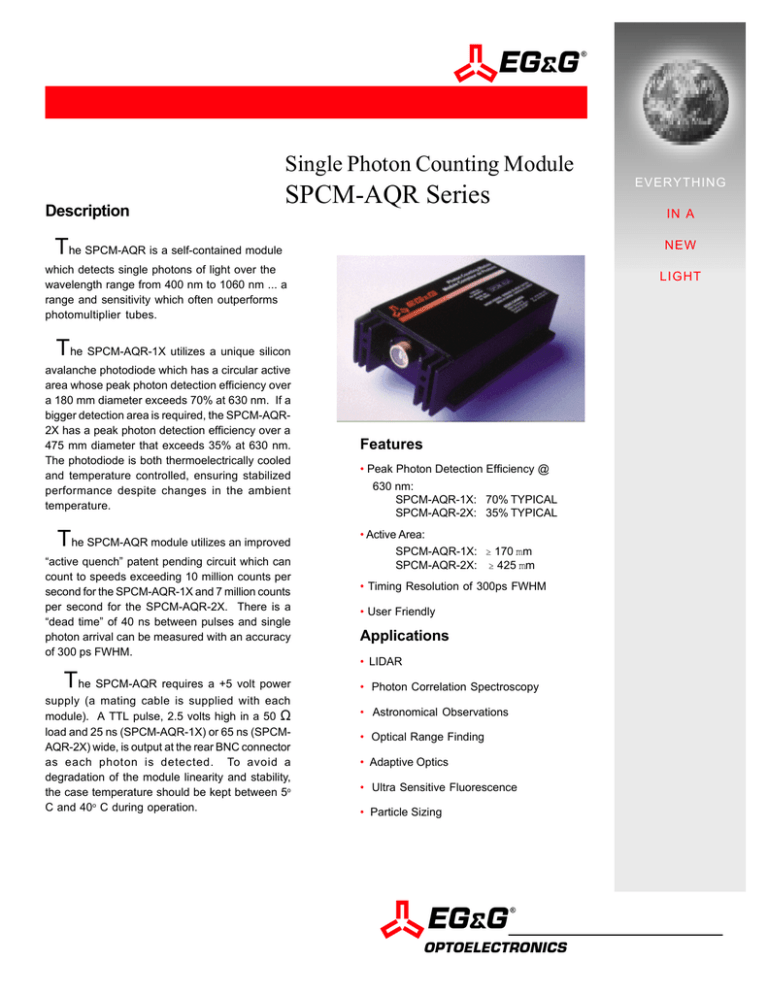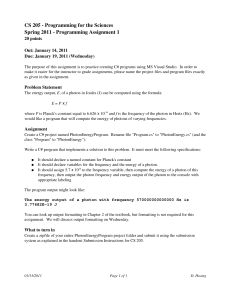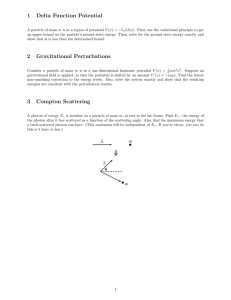Í SPCM-AQR Series Single Photon Counting Module
advertisement

Í Single Photon Counting Module Description SPCM-AQR Series IN A The SPCM-AQR is a self-contained module NEW which detects single photons of light over the wavelength range from 400 nm to 1060 nm ... a range and sensitivity which often outperforms photomultiplier tubes. LIGHT The SPCM-AQR-1X utilizes a unique silicon avalanche photodiode which has a circular active area whose peak photon detection efficiency over a 180 mm diameter exceeds 70% at 630 nm. If a bigger detection area is required, the SPCM-AQR2X has a peak photon detection efficiency over a 475 mm diameter that exceeds 35% at 630 nm. The photodiode is both thermoelectrically cooled and temperature controlled, ensuring stabilized performance despite changes in the ambient temperature. The SPCM-AQR module utilizes an improved “active quench” patent pending circuit which can count to speeds exceeding 10 million counts per second for the SPCM-AQR-1X and 7 million counts per second for the SPCM-AQR-2X. There is a “dead time” of 40 ns between pulses and single photon arrival can be measured with an accuracy of 300 ps FWHM. T he SPCM-AQR requires a +5 volt power supply (a mating cable is supplied with each module). A TTL pulse, 2.5 volts high in a 50 S load and 25 ns (SPCM-AQR-1X) or 65 ns (SPCMAQR-2X) wide, is output at the rear BNC connector as each photon is detected. To avoid a degradation of the module linearity and stability, the case temperature should be kept between 5o C and 40o C during operation. EVERYTHING Features • Peak Photon Detection Efficiency @ 630 nm: SPCM-AQR-1X: 70% TYPICAL SPCM-AQR-2X: 35% TYPICAL • Active Area: SPCM-AQR-1X: $ 170 mm SPCM-AQR-2X: $ 425 mm • Timing Resolution of 300ps FWHM • User Friendly Applications • LIDAR • Photon Correlation Spectroscopy • Astronomical Observations • Optical Range Finding • Adaptive Optics • Ultra Sensitive Fluorescence • Particle Sizing Í OPTOELECTRONICS SATURATION At higher incoming light levels, the count levels out and then decreases as light levels continue increasing. The count at which the output rate levels out is called the saturation point. As an extreme example, if the module is exposed to intense light the count rate will fall to zero. Consequently, in certain applications, some test should be performed by the operator to ensure that a low count rate is not caused by detector saturation. Some precaution shall be taken to avoid any excessive light level that will damage the SPCM module. FIBER CONNECTOR OPTION - Ordering Guide 1 The SPCM-AQR-WX-FC has an “FC” fiber optic receptacle prealigned to the optical detector. Optical fibers with an FC connector on one end are available separately. See ORDERING GUIDE 2. The photon detection efficiency of connectorized modules is about 95% of that quoted for standard modules. Fiber Shielding When used with optical fibers, both the fiber itself and the connector shrouds must be completely opaque; if not, stray light will increase the count rate. The SPCM-QCX pigtails conform to this requirement, see ORDERING GUIDE 2. GATING FUNCTION A gating function is provided with each module. It is useful when you are looking for a signal that occurs only in a small time frame window. Also, in some applications the background light flux is higher than the signal. In this case, the gating option could be used to improve the S/N ratio by opening a window only when the light signal is present. The detector is disabled when a “low” level is applied to the module gate input; see specification table for threshold level. TIMING RESOLUTION If the typical 300 ps FWHM (SPCM-AQR-1X) timing resolution is inadequate, then a custom selection is currently available for a better timing resolution. Call the factory for details. LIGHT EMISSION DURING PHOTON DETECTION One peculiarity of silicon avalanche photodiodes is that as an incoming photon is detected, a small amount of light is emitted from the avalanche region. The light emitted has a broad spectral distribution. In most cases this is not a problem. However, it can cause some confusion if another detector is monitoring light, or if the optical system is such that light emitted from the SPCM-AQR is reflected back on itself. If these photons return time exceed the SPCM-AQR dead time, they will be detected. SAFETY The SPCM-AQR contains a high voltage power supply. All internal settings are preset; there are no user adjustments. Units which appear defective or have suffered mechanical damage should not be used because of possible electrical shorting of the high voltage power supply. WARRANTY A standard twelve month warranty following shipment applies. Any warranty is null and void if the module case has been opened. ORDERING GUIDE 1: SPCM - AQR - W X - F C FC Connector Option Dark Count Selection FC Connector attached 1 Dark count < 2,000 c/s (-2X only) 2 Dark count < 500 c/s 3 Dark count < 250 c/s Chip Type Selection 4 Dark count < 100 c/s (-1X only) 5 Dark count < 50 c/s (-1X only) 6 Dark count < 25 c/s (-1X only) 1 200 µm diam Slik TM 2 500 µm diam C30902S ORDERING GUIDE 2: Standard fiber pigtail options. Standard length is 1.0 " 0.1 meters. Standard pigtail is FC terminated at one end, bare fiber at free end. PART NUMBER FIBER TYPE FIBER MANUFACTURER DIAMETER NUMERICAL APERTURE CORE CLADDING OUTER SPCM-QC4 Multimode Canstar 62.5 µm 125 µm 2.5 mm 0.27 SPCM-QC6 Multimode Canstar 100 µm 140 µm 2.5 mm 0.29 SPCM-QC8 As SPCM-QC6 but 905 SMA on free end SPCM-QC9 As SPCM-QC-6 but FC connector on free end Specifications: SPCM-AQR-WX @ 22 o PARAM ETER S u p p ly vo ltag e : 1 .9 A m a x., 0 .5 A ty p . th e m o d ule co n ne cto r E G & G p o w e r c a ble to ta l re sistan ce (1 ,4 ) C a s e op e ra tin g te m p e ra tu re (1 ,2 ) M IN 4 .7 5 @ TYP 5 .0 1X 170 2X 425 1X 180 2X 475 1X 2 .0 55 40 1 .0 2X 1X 5 .0 70 50 2 .0 2X 1 .5 35 25 1 .0 TBD S P C M -A Q R -2 1 S P C M -A Q R -W 2 S P C M -A Q R -W 3 S P C M -A Q R -1 4 S P C M -A Q R -1 5 S P C M -A Q R -1 6 A ve ra ge d a rk co u nt va ria tio n a t co nsta n t cas e o (5,6 ) : te m p e ra tu re (6 h rs @ 2 5 C ) for S P C M -A Q R -2 1 & -W 2 & -W 3 S P C M -A Q R -1 4 & -1 5 & -1 6 ± 4 1 ,0 0 0 250 150 50 - ± 10 2 ,0 0 0 500 250 100 50 25 % % C o u n ts/s ± 10% ± 1σ ± 20% ± 2σ S in g le P h o to n Tim in g R eso lu tion 1X 300 D e a d tim e (C ou n t ra tes b elo w 5 M c/s) 1X 40 1X 15 1X 1 .0 1 1 .0 8 1 .4 0 1X 0 .1 5 1X 10 2X 5 (7 ) S e ttlin g tim e fo llo w ing p o w e r u p (1 % s ta bility ) o @ 1 M e g cou n ts /se c a n d 2 5 C T h re sh o ld setting re qu ired fo r digita l o u tp u t p u lse (te rm ina te in 50 o h m s) % ± 3 o (1) µm ± 1 A ve ra ge d a rk co u nt va ria tio n , 5 C to 4 0 C (5 ,6 ) : ca se te m p e ra tu re fo r S P C M -A Q R -2 1 & -W 2 & -W 3 S P C M -A Q R -1 4 & -1 5 & -1 6 L in e a rity c o rre c tio n fa cto r: @ 2 0 0 kc /s @ 1 M c/s @ 5 M c/s A fte rp uls in g p ro b ab ility Ω C o 40 (5 ) O u tp u t co u nt ra te b e fo re s a tu ration U N IT S V 0 .2 P h o to n d e tec tio n efficien cy (P d ) @ λ = 4 0 0n m 630nm 830nm 1060nm P d va ria tio n a t c on sta n t c ase te m pe ra tu re o (2 h @ 2 5 C ) o o P d va ria tio n , 5 C to 4 0 C cas e te m pe ra tu re o MAX 5 .2 5 5 A ctive a re a (dia m e te r) @ m inim u m P d D a rk co u n t C, all models, unless otherwise indicated. 0 .7 5 P u lse W idth 2X 30 00 2X 85 2X 10 2X 1X 50 1X 2X TBD 1 .1 5 1 .6 7 1X 0 .3 0 TBD 2X 1 .0 2X 100 ps FW HM ns M c/s 2X TBD % 15 30 s 1 .0 2 .0 V 1X 2X 25 65 ns G a tin g tu rn on /o ff: (5 0 Ω in p u t) D is a ble = T T L Lo w 2 4 ns E n a b le = T TL H igh 45 55 ns 0 0 .4 V 3 .5 5 .2 5 V G a te T h resh old vo lta g e (@ V su p p ly L o w lev e l (s in k cu rren t > 9 0 m A ) H ig h L ev el (sin k cu rre n t < 3 0 m A ) = 5V) Notes: 1. Absolute Maximum ratings: Supply Voltage 5.5V Mean Count Rate 5 Mc/s (Above this point, dead time will increase due to diode self-heating). Peak Count Rate The SPCM-AQR-15 and the SPCM-AQR-16 have a maximum count rate of 5 Mc/s Case Temperature 50o C Storage, 40o C Operating 2. Connection to incorrect voltage or reverse voltage may destroy the module. The warranty is invalid where such damage occurs. 3. These modules are not qualified for shock or vibration other than normal instrumentation environments. 4. The module dissipates a mean power of 2.5W, and a maximum power of 10W at high count rate and 40oC. Adequate heatsinking must be provided by clamping the module to a suitable heatsink via the holes in the module base. For the specification performance, the module case temperature must not exceed 40oC. 5. Bistability of the dark count. On a small percentage of delivered modules, bistability of the dark count has been observed. Research indicates that this bistability is probably due to transitions at a single impurity site between a lower energy and a high energy state. The phenomenon is seen as an abrupt change in the dark count rate, e.g. 350 to 390 c/s, and the dark count switches between the two states at a rate which depends on the detector temperature. Multilevel switching has also been observed, where more than one impurity site is switching. 6. In the dark the module generates random counts that follow a “Poission” distribution. In a Poissonnian process the standard deviation (s) is equal to the square root of the average counts. In this specification the “dark count variation” refers to the stability of the average count of the module . 7. The actual photon rate could be calculated using the following equation: ACTUALCOUNT RATEPhotons = (OUTPUT ModuleCount Rate x CORRECTION FACTOR@ the ModuleCount Rate)- DARK COUNT Module PHOTON DETECTION EFFICIENCY Module The theoretical value, at low count rate, of the correction Factor follows this equation: Correction Factor = 1 1 - ( τ D x CR ) Where: t D = Module Dead Time CR = Output Count Rate The deviation from an ideal linear system is another way of looking at the saturation effect. The following equations shows how to calculate this departure from the linearity: LINEARITY = OUTPUT Module Count Rate (PHOTONS Actual Count Rate x PHOTON DETECTION EFFICIENCY Module) + DARK COUNT Module 1 = -1 Correction Factor -1 Block Diagram of Module Electrical Connections The digital output pulse, $ 2.5V, should be terminated with a 50S load to avoid distortion and ringing. A 1.0V triggering level is recommended. The gate input impedance is a 50S pull-up resistor to the +5V supply. 50 70 45 60 40 35 50 45-50 40-45 30 40 35-40 60-70 25 Pd (%) 50-60 Pd (%) 30-35 25-30 40-50 30 20 20-25 30-40 15-20 15 20-30 20 10-20 10-15 5-10 10 0-10 0-5 5 10 0 0 600 µm 500 400 600 500 600 500 µm 700 600 700 500 400 300 200 µm 300 200 400 300 400 300 100 200 100 µm 200 100 0 100 0 Fig.1: SPCM-AQR-1X Photon Detection Scan @ 650nm Fig. 2: SPCM-AQR-2X Photon Detection Scan @ 650nm AFTER-PULSE MEASUREMENTS USING BROOKHAVEN 16 CHANNELS OF 25ns SPCM-AQR-1X Total after-pulse = 0.25% 80% 0.10% 70% Autocorrelation Function Photon Detection Efficiency (Pd) 0.09% 60% 0.08% 0.07% 50% 0.06% 40% 0.05% 30% 0.04% 0.03% 20% 0.02% 10% 0.01% 0% 300 0.00% 400 500 600 700 800 900 1000 0 1100 50 100 150 250 300 350 400 Fig. 4: SPCM-AQR-1X Typical After Pulse Probability Fig. 3: SPCM-AQR-1X Photon Detection Efficiency vs Wavelength 9 100E+6 8 N(λ ), Number of Photons / second 10E+6 7 Correction Factor 200 Time in nanosecond Wavelength (nm) 6 SPCM-AQR-2X 5 4 SPCM-AQR-1X 3 2 1E+6 100E+3 N(λ) = 5.03 E15 x λ x P where λ is wavelength in nm and P is the optical power 400 nm 630 nm 830 nm 1060 nm 10E+3 1E+3 100E+0 10E+0 1 0 2 4 6 8 10 Count Rate in Million counts per second Fig. 5: Typical Correction Factor 12 14 16 1E+0 1E-18 10E-18 100E-18 1E-15 10E-15 100E-15 P, Optical Power (watts) Fig. 6: Optical Power vs Number of Photons at Various Wavelengths 1E-12 10E-12 450 Dimensional Outline Dimensions in mm (inches). Do not warp the module walls during mounting since electronic components are attached to them. The rated case temperature is 5o to 40oC, so it is necessary to ensure good heatsinking or ventilation. EG&G welcomes inquiries about special types. We would be pleased to discuss the requirements of your application and the feasibility of designing a type specifically suited to your needs. Íis a registered trademark of EG&G, Inc. Í OPTOELECTRONICS All values are nominal; specifications subject to change without notice. For more information e-mail us at eod@egginc.com or visit our Web site at www.egginc.com/opto EG&G 22001 Dumberry Road Vaudreuil, Quebec J7V 8P7 Canada 1-800-775-OPTO (USA) Tel: (450)-424-3300 Fax: (450)-424-3411 ©1998 EG&G, Inc. All rights reserved July 16/99






